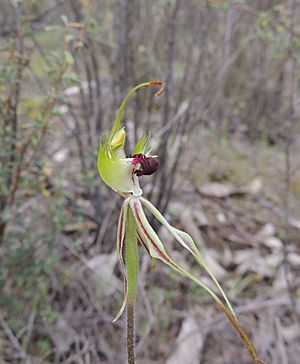Brown-clubbed spider orchid facts for kids
Quick facts for kids Brown-clubbed spider orchid |
|
|---|---|
 |
|
| Caladenia phaeoclavia in Namadgi National Park | |
| Scientific classification | |
| Genus: |
Caladenia
|
| Species: |
phaeoclavia
|
| Synonyms | |
|
|
The Caladenia phaeoclavia, also known as the brown-clubbed spider orchid, is a unique type of orchid. It grows only in New South Wales, Australia. This special plant has one hairy leaf. It also produces a single flower that is light to dark green. The flower has red stripes and thick, brownish, club-like tips on its sepals.
What it Looks Like
The brown-clubbed spider orchid is a plant that grows from the ground. It is a perennial plant, meaning it lives for more than two years. It is also deciduous, so some parts might die back in certain seasons. This plant has an underground tuber, which is like a swollen stem that stores food.
It has one dull green leaf that is hairy. The leaf is shaped like a line or a spear. It can be about 60 to 130 mm (2.4 to 5.1 inches) long. It is also about 5 to 9 mm (0.2 to 0.4 inches) wide. You might see reddish-purple spots near the bottom of the leaf.
A single flower grows on a thin, hairy stem. This stem can be about 100 to 250 mm (3.9 to 9.8 inches) tall. The flower itself is about 35 mm (1.4 inches) wide.
Flower Details
The sepals and petals of the flower are pale to dark green. They each have a dark red stripe down the middle. The sepals are like the outer leaves that protect the flower bud. These sepals have thick, brownish, club-like tips. These tips are about 10 mm (0.4 inches) long.
The top sepal, called the dorsal sepal, stands upright. It curves slightly forward. It is about 30 to 42 mm (1.2 to 1.7 inches) long. It is also about 2 mm (0.08 inches) wide. The side sepals, called lateral sepals, are also 30 to 42 mm long. They are about 3 mm (0.12 inches) wide and spread downwards.
The petals are about 20 to 26 mm (0.8 to 1.0 inches) long. They are about 2 mm (0.08 inches) wide. They are arranged in a similar way to the side sepals.
The labellum is a special lip-like part of the orchid flower. It is about 15 to 17 mm (0.6 to 0.7 inches) long. It is also about 14 to 18 mm (0.6 to 0.7 inches) wide. The labellum is green and white with a dark red tip. This tip is usually curled underneath. The sides of the labellum curve strongly upwards. They have five or six teeth on each side. These teeth can be up to 3.5 mm (0.14 inches) long.
In the center of the labellum, there are four rows of dark red, club-shaped structures. These are called calli. They are up to 2 mm (0.08 inches) long. This orchid usually flowers from October to November.
How it Got its Name
The brown-clubbed spider orchid was first officially described in 1999. This was done by a botanist named David Jones. He found a specimen of the plant near Yetholme in the Wambool Nature Reserve. The description was then published in a scientific book called Australian Orchid Research.
The scientific name, phaeoclavia, comes from two old words. Phaios is an Ancient Greek word meaning "brown." Clava is a Latin word meaning "club." These words describe the brown, club-like tips found on the sepals of the flower.
Where it Lives
The brown-clubbed spider orchid is found in New South Wales, Australia. It grows south from the Bathurst area. You can often find it in eucalypt forests. It prefers to grow on ridges and slopes. Scientists think it might also grow in Victoria.

